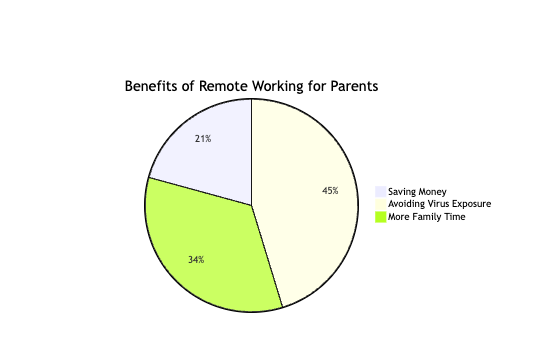By the Numbers: How Many Parents Are Really Working from Home?
The COVID-19 pandemic dramatically reshaped how many employees approach work, as companies rapidly shifted to remote and hybrid arrangements.
For working parents, these new flexible policies provided opportunities but also posed challenges balancing jobs and childcare duties. Now a few years later, what do the statistics show about how many moms and dads continue to utilize remote and hybrid schedules?
Get this – 58% of parents with kids under 18 were working remotely most or all of the time last year! Crazy right? That’s way up from only 44% before the pandemic hit. I don’t know about you, but I think that’s pretty amazing.
Just imagine – no more rushing to get everyone dressed and out the door to beat traffic every morning. You get to have breakfast with the family, walk the kids to the bus stop, and log on to work in your PJs if you want! Not to mention saving a bundle on gas, parking fees, dry cleaning and takeout lunches. One survey found remote working parents saved $51-100 per week. What would you do with all that extra cash and free time?
Here’s the kicker – 61% of parents actually want to keep this flexible arrangement even after COVID-19 is over. People are digging this new lifestyle and I don’t blame them! The pandemic unexpectedly opened the door to a whole new way of balancing work and family life.
Don’t get me wrong, it’s not all rainbows and unicorns. Trying to juggle Zoom meetings, homeschooling, and snack time is no picnic. But for a lot of moms and dads, the benefits outweigh the challenges. This could be a game-changer in creating a more family-friendly work culture down the road.
At the end of the day, parents are just trying to do their best to balance jobs and kids. If working from home eases some of that pressure, I say we embrace it!
The genie is out of the bottle and it doesn’t look like it’s going back in anytime soon.
Pandemic Drove Increased Remote Work for Parents
The impact of the pandemic on remote work for parents is evident in the numbers.
- According to SWAA, as of August 2023, 30% of full-time employees worked in a hybrid arrangement, splitting time between home and the workplace.
- 58% of surveyed parents with children under 18 reported working remotely all or most of the time in 2021, up from 44% pre-pandemic (Pew Research Center, 2022). This represents a major increase in remote work among parents.
- 75% of surveyed parents worked from home more frequently during the pandemic according to McKinsey, showing COVID-19 restrictions drove remote work (2021).
- 25% of remote working parents reduced work hours or left jobs due to childcare and schooling responsibilities in a FlexJobs survey (2021). This highlights the pandemic’s impact on parents’ employment.
Many Parents Prefer Continued Flexibility Post-Pandemic
As we transition to a post-pandemic world, many parents seem to favor remote work’s flexibility.
- 61% of surveyed parents report wanting to maintain primarily remote work even after the pandemic according to FlexJobs (2021). This points to a strong desire for ongoing flexibility.
- Over 50% of remote working parents surveyed wish they could work from home all or most days, including hybrid workers who want more days out of the office (Buffer, 2022).
- 78% say schedule flexibility is critical in managing work and family duties according to FlexJobs (2021). Flexibility appears highly valued by parents.
Productivity and Boundaries Pose Challenges
While remote work offers numerous advantages, it comes with its own set of challenges.
- 54% of remote working parents reported decreased productivity when starting remote work while caring for children at home per Adobe (2020). This underscores the challenge parents can face concentrating while working at home.
- 40% of remote working parents struggle to stop working after hours and unplug at home per FlexJobs (2021). Inability to set boundaries is a downside parents report.
- 60% of working parents experienced burnout amid increased remote work per FlexJobs (2021). The data indicates high pandemic stress levels among parents.
Benefits Like Saving Money and Time
Despite the challenges, remote work has its silver linings. Remote work offers benefits such as financial savings and increased time with family, offsetting some of its challenges.

- 33% of remote working parents estimate saving $51-100 per week on costs like commuting according to FlexJobs (2021). This points to significant financial savings.
- 72% cite avoiding virus exposure as a motivator for remote work per FlexJobs (2021). Safety from infections remains a benefit.
- 54% say remote work allows more family time according to Prudential (2021). Parents highlight time savings without commuting.
- 51% report increased productivity working from home per FlexJobs (2021). This shows home environments can enable focus for some.
How Do Current Statistics Compare to Early Pandemic Data?
Interestingly, remote work among parents has slightly dipped from its peak during the early stages of the pandemic. In mid-2020 surveys, even higher percentages of parents worked remotely than today:
- Pew found 55% of parents with children under 18 worked from home full-time in October 2020, fallen to 58% now working remotely most or all of the time (Pew Research Center, 2022).
- 75% of parents worked from home more often during pandemic restrictions according to McKinsey (2021). The figure has likely dipped as restrictions eased.
So while remote work has decreased slightly from peak pandemic conditions, it remains far above pre-2020 levels for parents. Many companies now implement hybrid policies keeping some on-site work.
What About Accessibility for Low-Income Parents?
A notable gap in these trends is the discrepancy in remote work accessibility between higher-income and lower-income parents. An important caveat in the data is that remote work remains much more accessible to higher-income parents:
- 61% of U.S. workers lack jobs suitable for remote work, including many lower-wage roles, per Pew Research Center (2022).
- Low-income parents were often deemed “essential workers” required on-site during the pandemic.
- Lack of flexibility disproportionately impacts lower-income parents’ ability to balance work and family.
The statistics show clear socioeconomic divides. While many parents now utilize remote or hybrid arrangements, those with lower incomes often lack access. Companies and policymakers may need to address these gaps.
How Do Working Fathers Compare to Working Mothers?
Among parents able to work remotely, mothers do so at higher rates than fathers:
- 58% of working mothers were remote in 2021 compared to 51% of fathers per Pew Research Center (2022).
- Working mothers provide over 14 more hours of childcare per week than fathers when working from home according to a 2020 study.
- 25% of working mothers reduced work hours in the pandemic versus 15% of fathers per McKinsey (2021).
Mothers still shoulder more childcare duties while also telecommuting. Some research suggests remote work could promote gender equity, but further progress is needed on sharing parenting responsibilities.
What Do the Statistics Say About the Future of Remote Work for Parents?
With 61% of surveyed parents desiring to maintain increased remote flexibility post-pandemic according to FlexJobs (2021), companies will need to evaluate long-term arrangements. Leaders should consider:
- Making hybrid or remote schedules widely available, including for lower-wage roles.
- Focusing on output rather than hours logged when evaluating remote productivity.
- Providing manager training on overseeing remote employees.
- Developing social and community initiatives to reduce isolation.
- Exploring childcare support options.
The pandemic opened employer eyes to expanded remote possibilities within many roles. With parents strongly favoring these flexible approaches, adapting policies to this evolving workforce will be key. Of course, each organization has unique factors to weigh when determining optimal on-site, hybrid, and remote balances. But listening to parents’ perspectives is essential in shaping an inclusive future of work.
Sources:
- https://www.pewresearch.org/social-trends/2022/02/16/parents-with-children-under-18-more-likely-to-be-working-remotely-during-the-pandemic/
- https://www.mckinsey.com/business-functions/organization/our-insights/how-covid-19-has-pushed-companies-over-the-technology-tipping-point-and-transformed-business-forever#
- https://www.flexjobs.com/blog/post/remote-work-statistics-for-parents/
- https://www.adobe.com/content/dam/acom/en/products/acrobat/pdfs/adobe-remote-work-productivity-study.pdf
- https://news.prudential.com/american-workers-face-new-challenges-and-changes.htm
- https://buffer.com/state-of-remote-work/2022






